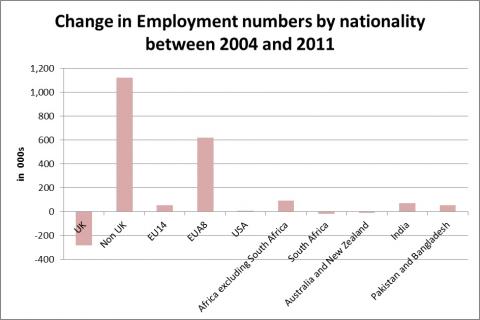Does immigration cost British workers jobs?
Chris Grayling: "[The growth of immigration] has contributed to a higher level of unemployment than would otherwise have been the case."
Nicola Smith: "The evidence shows that immigration has a small net positive impact on employment levels in the UK."
Newsnight, 15 May 2012
Employment Minister Chris Grayling and TUC economist Nicola Smith locked horns last week on BBC's Newsnight as the programme probed the supposed link between rising migration and unemployment.
While Mr Grayling was adament that the two were linked, Ms Smith insisted that all the evidence suggested that migration had had a positive impact on the UK labour market, albeit a slight one.
What is the evidence?
Newsnight illustrated the trends by comparing the growth in the number of EU A8 migrants - those from eight former Soviet-bloc countries in Eastern Europe - with the increase in youth unemployment, as the graph below shows:

The data is sourced from Migration Watch report which, using ONS figures, concluded that the link between youth unemployment and immigration is more than a coincidence, and the impact of immigration on the UK labour market "has cleary been significant".
Between January-March of 2004 and July-September 2011 the ONS recorded an increase of 616,000 in the number of employed workers born in A8 countries. Over this same period the number of jobless 16-24 year olds (of all nationalities) rose from approximately 575,000 to just over a million.
But how representative are the EU A8 countries of migration as a whole? As we can see from the graphs below, this group of countries accounted for 55 per cent of the overall increase in all employed non-UK nationalities between 2004 and 2011:

Is there a link?
So while we can say that there certainly has been an increase in the number of UK youth unemployed at the same time as the UK sees an increase in non-UK born workers in employment, we can't necessarily know that the two trends are intertwined.
A number of studies have looked at this perceived link, and the findings have been summarised by Oxford University's Migration Observatory.
Two recently released reports on the relationship between immigration and unemployment merit closer inspection.
The first, released by the National Institute of Economic and Social Research (NIESR) is entitled "Examining the relationship between immigration and unemployment using National Insurance Number registration data".
The report uses data on National Insurance Number allocations to adult overseas nationals entering the UK as the input for migrant inflow employment, on the basis that this measure focuses the data specifically on employment-driven migration.
It then looks in detail at the areas in which these migrants settle to determine if there is any impact upon the local economy.
The raw data used by NIESR indicates very minor positive correlation between native unemployment and immigration, the same trend identified by Ms Smith.

However, the report suggests that any positive correlation is too minor to draw any firm conclusions about the labour market benefits of migration:
"Our results seem to confirm the lack of impact of migration on unemployment in aggregate. We find no association between migrant inflows and claimant unemployment.
"Overall therefore, our results indicate a lack of any significant correlation between migrant inflows and changes aggregate claimant count rates, in line with the general message emerging from previous research that migration has had generally negligible effect on unemployment rates."
This assessment differs from the view put forward by both Chris Grayling and Migration Watch. However, it also does not fully substantiate Nicola Smith's assertion that a small net positive impact on employment in the UK results from immigration.
The second report, published by the UK Border Agency's (UKBA) Migration Advisory Committee also explores the relationship between native unemployment and immigration.
It concluded:
"We find no association between working-age migrants and native employment: (i) in buoyant economic times; (ii) for EU migrants; (iii) for the period 1975-1994. By contrast, we find a negative association between working-age migrants and native employment: (i) in depressed economic times; (ii) for non-EU migrants; (iii) for the period 1995-2010."
Conclusion
The links drawn between rises in EU A8 migration and youth unemployment by Chris Grayling and Migration Watch don't necessarily give the full picture. Analyses of the figures conducted by NIESR and the Migration Advisory Committee both found that when it came to migration from the EU, there was no link between immigration and unemployment.
The MAC report does however note that non-EU migration can have a negative impact upon the labour market, particularly at times of economic hardship. This would suggest that Chris Grayling's claim might have greater weight if we expand the analysis beyond the EU A8 countries considered by Newsnight.